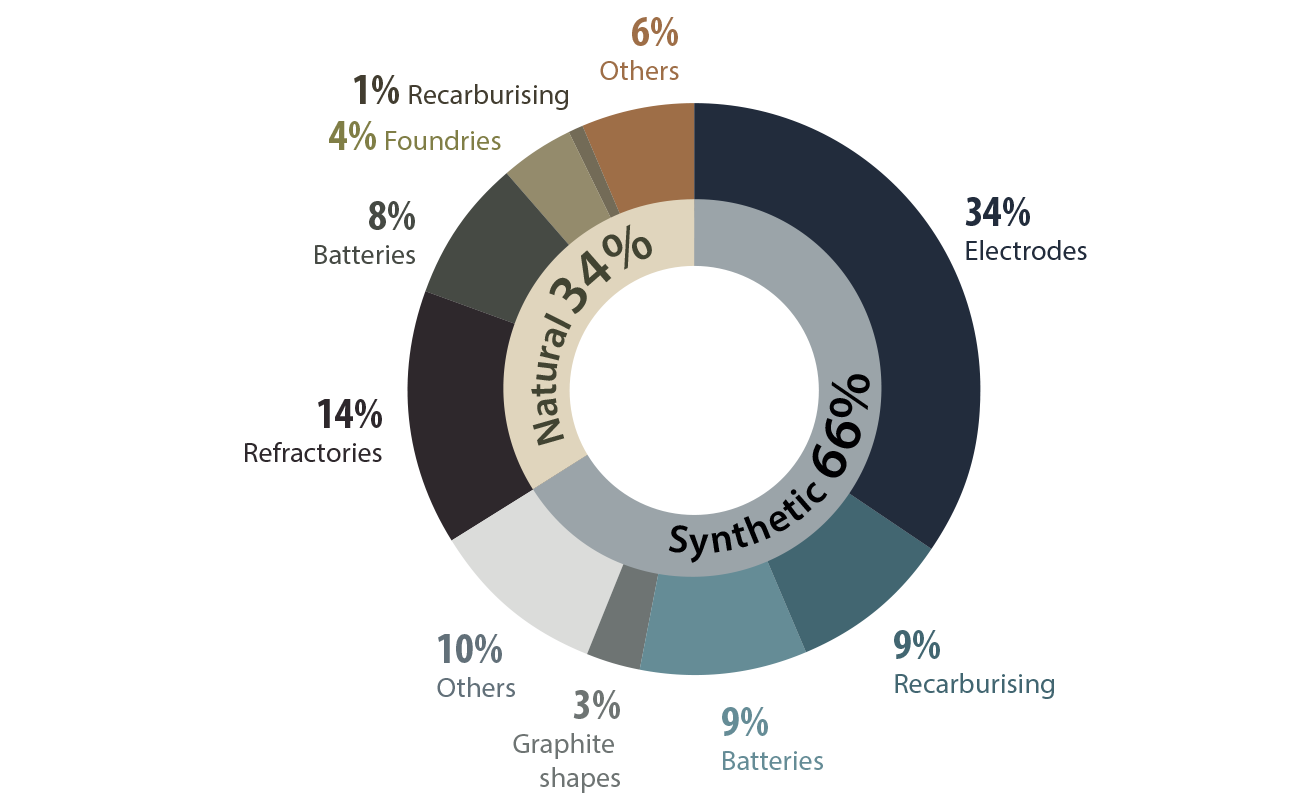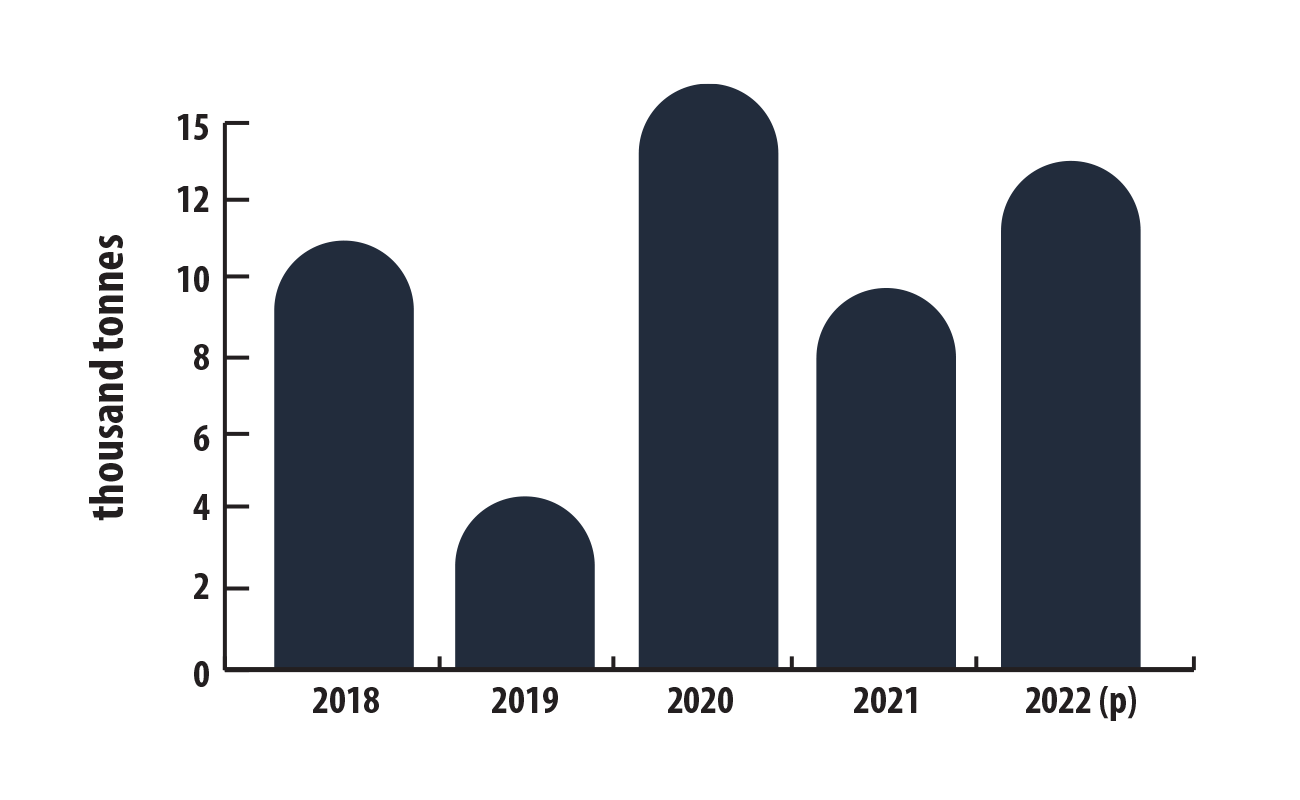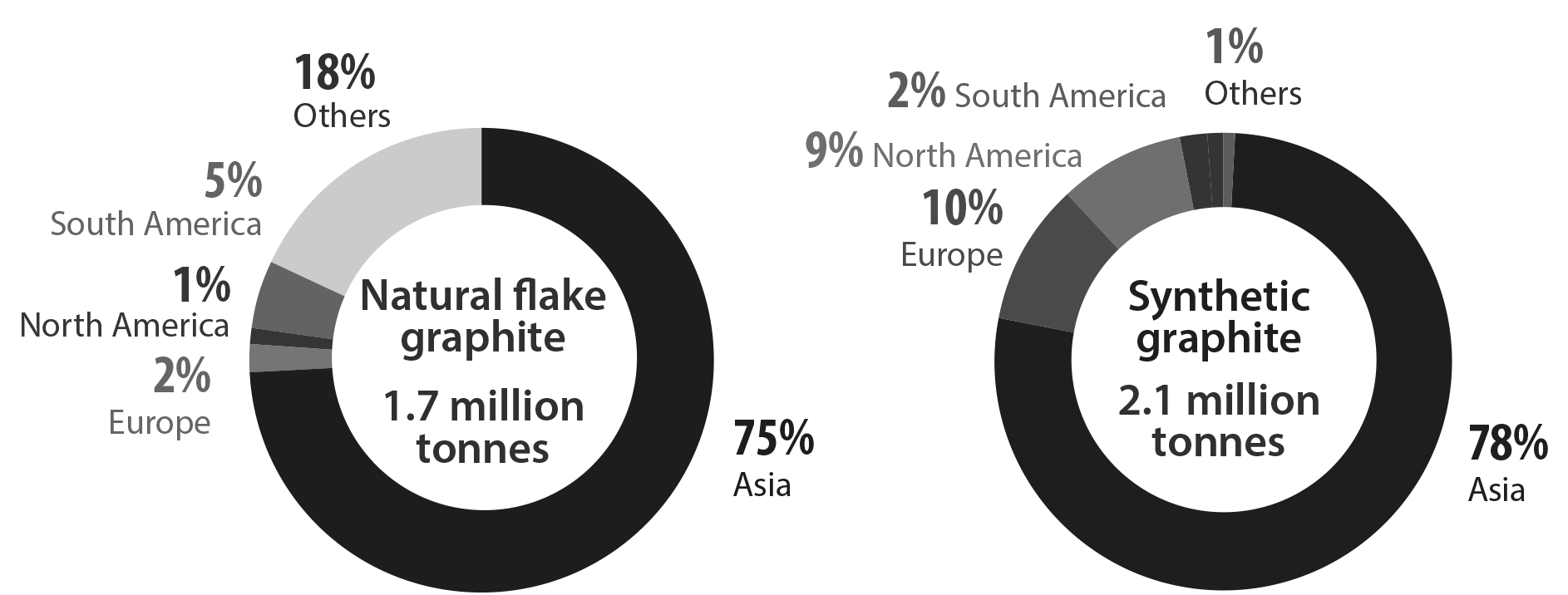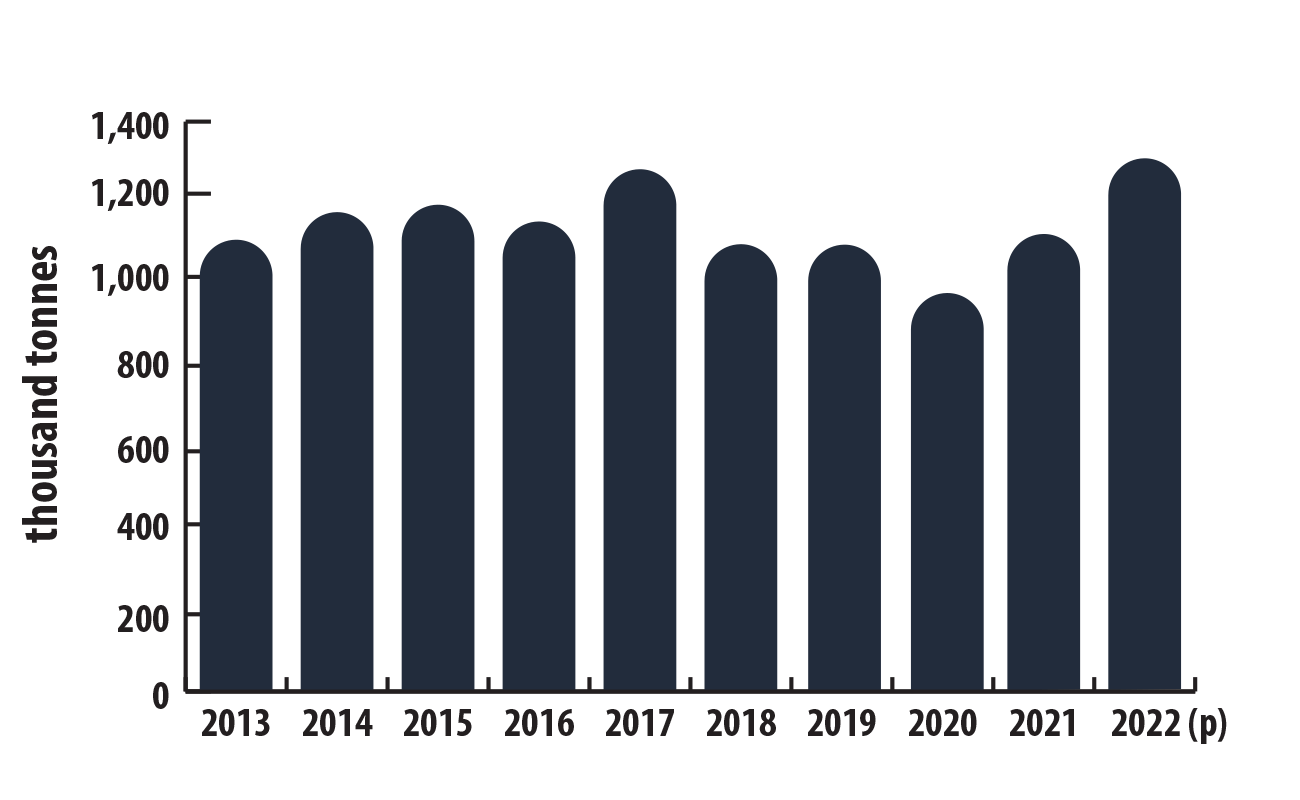Graphite facts

Graphite is a non-metallic mineral that has properties similar to metals, such as a good ability to conduct heat and electricity. Graphite occurs naturally or can be produced synthetically. Purified natural graphite has higher crystalline structure and offers better electrical and thermal conductivity than synthetic material.
Key facts
- In 2022, global graphite mine production was about 1.3 million tonnes, a 15% increase from 2021.
- Canadian natural graphite production comes from the Lac des Iles mine in Quebec.
- Canada ranks as the sixth global producer of graphite with 13,000 tonnes of production in 2022.
- Canada exported $22 million worth of natural graphite and $14 million worth of synthetic graphite globally in 2022, mostly to the United States.
Learn more about graphite
 Uses
Uses
Among the many applications, natural and synthetic graphite are used for electrodes, refractories, batteries and lubricants and by foundries. Coated spherical graphite is used to manufacture the anode in lithium-ion batteries. High-grade graphite is also used in fuel cells, semiconductors, LEDs and nuclear reactors.
Graphite, global uses, 2021

Text version
This circular chart shows the major global uses of natural (34%) and synthetic (66%) graphite. Synthetic graphite is used for electrodes (34%), recarburising (9%), batteries (9%), graphite shapes (3%) and other (10%). Natural graphite is used for refractories (14%), batteries (8%), foundries (4%), recarburising (1%) and other uses (6%).
 Production
Production
The Lac des Iles mine in Quebec is the only mine in Canada that produced graphite in 2022. However, many other companies are working on advancing graphite projects. Canada produced 13,000 tonnes of natural graphite in 2022, which was an increase from 2021 of 9,743 tonnes.
Canadian mine production of graphite, 2018–2022 (p)

Text version
This bar graph shows Canada's annual mine production of natural graphite from 2018 to 2022. The production of graphite mines in Canada was 11,000 tonnes in 2018. Production declined to 4,332 tonnes in 2019. There was a significant increase to 16,239 tonnes in 2020, followed by a decline to 9,743 tonnes in 2021. In 2022, natural graphite production in Canada rose 33% to 13,000 tonnes.
 International context
International context
Global production and demand for graphite are anticipated to increase in the coming years, largely because of the use of graphite in the batteries of electric vehicles. In 2022, global consumption of graphite reached 3.8 million tonnes, compared to 3.6 million tonnes in 2021. Synthetic graphite accounted for about 56% of the graphite consumption, which was concentrated largely in Asia. North America consumes only 1% of global natural graphite, but almost 9% of synthetic graphite.
Global consumption of graphite by type and region, 2022

Text version
These pie charts display the share of graphite consumption by type and region in 2022. Asia accounted for 75% of the 1.7 million tonnes of natural flake graphite consumed globally, Europe 2%, South America 5%, North America 1%, and Others 18%. Asia accounted for 78% of the 2.1 million tonnes of synthetic graphite consumed globally, Europe 10%, North America 9%, South America 2%, and Others 1%.
Global mine production of graphite was 1.3 million tonnes in 2022, up 15% compared to the previous year. China is the leading global producer, accounting for 66% of production in 2022. Canada ranks sixth globally for natural graphite production, producing about 1% of global natural graphite.
| Ranking | Country | Thousand tonnes | Percentage of total |
|---|---|---|---|
| 1 | China | 850.0 | 65.6% |
| 2 | Mozambique | 170.0 | 13.1% |
| 3 | Madagascar | 110.0 | 8.5% |
| 4 | Brazil | 87.0 | 6.7% |
| 5 | Russia | 15.0 | 1.2% |
| 6 | Canada | 13.0 | 1.0% |
| 7 | Norway | 10.0 | 0.8% |
| 8 | India | 8.3 | 0.6% |
| 9 | North Korea | 8.1 | 0.6% |
| 10 | Ukraine | 3.0 | 0.2% |
| Other | 21.6 | 1.6% | |
| World total (rounded) | 1,296.0 | 100.0% |
World mine production of graphite, 2013–2022 (p)

Text version
This bar graph shows global annual mine production of graphite from 2013 to 2022. The production of graphite mines globally was 1.112 million tonnes in 2013 and grew to 1.176 million tonnes in 2014 and 1.188 million tonnes in 2015. In the following years, production fell to 1.149 million tonnes in 2016 and to 0.871 million tonnes in 2017, then increased to about 1.094 million tonnes in both 2018 and 2019. Global production declined in 2020 to 0.974 million tonnes and rebounded to 1.128 million tonnes in 2021. In 2022, global graphite production rose 15% to 1.298 million tonnes.
World reserves with the largest volume of graphite
In 2022, global reserves of graphite were estimated to be 330 million tonnes. Turkey has the largest reserves of graphite, followed by Brazil and China. Together these three countries accounted for 66% of the estimated world graphite reserves.
Canada ranks ninth globally for graphite reserves at an estimated 5.9 million tonnes or 1.8% of the world total.
| Ranking | Country | Million tonnes | Percentage of total |
|---|---|---|---|
| 1 | Turkey | 90.0 | 27.3% |
| 2 | Brazil | 74.0 | 22.4% |
| 3 | China | 52.0 | 15.8% |
| 4 | Madagascar | 26.0 | 7.9% |
| 5 | Mozambique | 25.0 | 7.6% |
| 6 | Tanzania | 18.0 | 5.5% |
| 7 | India | 8.0 | 2.4% |
| 8 | Uzbekistan | 7.6 | 2.3% |
| 9 | Canada | 5.9 | 1.8% |
| 10 | Mexico | 3.1 | 0.9% |
| Other | 20.4 | 6.2% | |
| Total | 330.0 | 100.0% |
 Trade
Trade
In 2022, the value of Canada’s domestic exports of graphite was $36 million, a 9.3% decline compared to the previous year. Meanwhile, imports increased in 2022, by 11% to $25.7 million.
Natural graphite accounted for 60.7% ($21.8 million) of the value of Canada’s domestic exports of graphite and 16.8% ($4.3 million) of Canada’s imports of graphite in 2022. Synthetic graphite accounted for 39.3% ($14.1 million) of Canada’s exports of graphite and 83.2% ($21.4 million) of Canada’s imports of graphite in 2022.
In 2022, the United States was the primary destination for Canada’s exports of natural and synthetic graphite, accounting for 81% and 58% of the total export value, respectively. In addition, Canada also exported natural graphite to 17 other countries and synthetic graphite to 20 other countries.
 Prices
Prices
The market price for graphite is not readily available because natural and synthetic graphite transactions are based mostly on direct negotiations between the buyer and seller.
Natural graphite prices tend to be determined based on a range of factors such as graphite content, flake size and impurity level.
As the largest global producer, China naturally influences international prices, which are provided mainly by large, high-volume buyers and tend to be conservative. Most small buyers tend to pay higher prices.
 Recycling
Recycling
Although currently small, the market for recycled refractory graphite material is expanding, with material being recycled into products such as brake lining and thermal insulation.
Although graphite is not commonly recovered from the recycling of lithium-ion batteries, a Quebec-based company is developing a hydrometallurgical process to recover most of the battery’s raw materials, including the graphite.
Notes and sources
(p) preliminary
Totals may be different because of rounding.
Uses
- Graphite, global uses, 2021
- Source: European Carbon and Graphite Association, ECGA Annual report 2021
Production
- Canadian mine production of graphite, 2018–2022 (p)
- Natural Resources Canada
- Data prior to 2017 are suppressed by the source.
International context
- Global consumption of graphite consumption by type and region, 2022 (p)
- Wood Mackenzie
- World mine production of graphite, by country, 2022 (p)
- United State Geological Survey
- Canadian values supplied by Natural Resources Canada
- World mine production of graphite, 2013–2022 (p)
- United States Geological Survey
- World reserves of graphite, by country, 2022 (p)
- United States Geological Survey
- Canadian values supplied by Natural Resources Canada, company reports. Values include reserves (proven and probable) at producing mines and advanced projects.
Trade
- Natural Resources Canada; Statistics Canada
- Trade data include the following graphite products: natural graphite, in powder or in flakes (HS code 2504.10); natural graphite; other (HS code 2504.90); and artificial graphite (HS code 3801.10).
Recycling
- United States Geological Survey
- Lithion Recycling (company)
Page details
- Date modified: